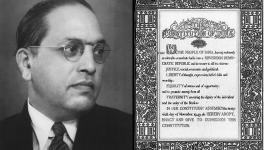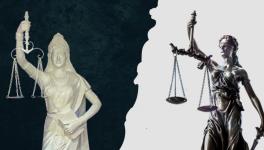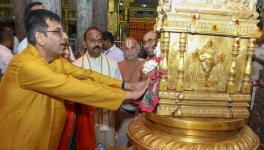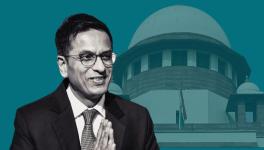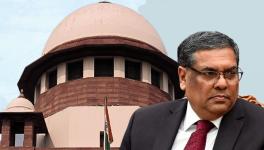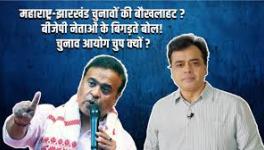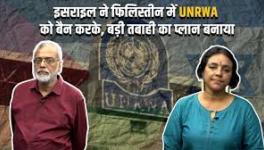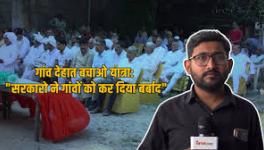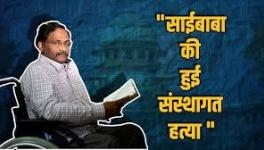Gods Above the Constitution: A New Era For India’s Judiciary?
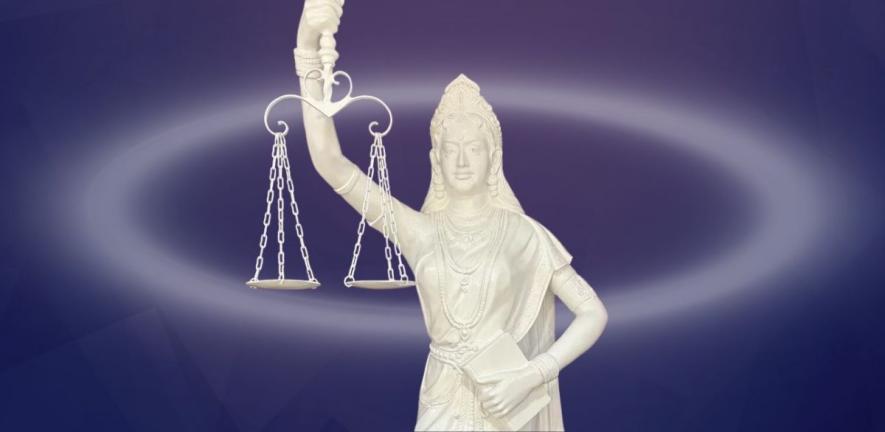
In a rare confession, the Chief Justice of India (CJI) Dr D.Y. Chandrachud disclosed in a recent meeting in his village in Maharashtra that the Ayodhya (Ram Janmabhoomi–Babri Masjid) dispute was adjudicated in the Supreme Court and a solution was arrived at after he sat before a deity and prayed for it.
He said, “Very often we have cases (to adjudicate) but we do not arrive at a solution. Something similar happened during the Ayodhya dispute which was in front of me for three months. I sat before the deity and told him he needed to find a solution.”
Demolition of Babri Masjid an “egregious violation of rule of law”
It is worthwhile to recall that the judgment on the above dispute was delivered by a Supreme Court Bench consisting, among others, of the then CJI Ranjan Gogoi and Justice Chandrachud. It sharply described the placement of the idol of Lord Ram inside Babri Masjid as illegal and held that its demolition and “the obliteration of the Islamic structure was an egregious violation of the rule of law”.
So the operative part of the judgment that the site of Babri Masjid should be used for building a Ram temple flowed, according to Chandrachud, from a deity.
It also allotted the site of the demolished mosque to those who destroyed it for the purpose of constructing a Ram temple and ordered to provide some five acres of land somewhere else to build a mosque.
Prayer to a deity superseded the Constitution
So the operative part of the judgment that the site of Babri Masjid should be used for building a Ram temple flowed, according to Chandrachud, from a deity whom he prayed for finding a judicial resolution of the Ayodhya (Ram Janmabhoomi–Babri Masjid) dispute.
It means that the principles of the Constitution, law and jurisprudence did not determine the process of adjudication, and a faith-based approach was adopted to invoke a divine figure to find a way out.
The Supreme Court in the judgment, allowing the construction of a Ram temple in Ayodhya, clearly stated that the judiciary would not be guided by any theology to adjudicate the matter.
It is worthwhile to invoke that paragraph of the judgment: “This court, as a secular institution, set up under a constitutional regime, must steer clear from choosing one among many possible interpretations of theological doctrine and must defer to the safer course of accepting the faith and belief of the worshipper.”
D.Y. Chandrachud, as the CJI, is integral to the secular institution of the Supreme Court wedded to secular ideals to find solutions to any matter being adjudicated by it. The deference to accept the faith and belief of worshippers as laid out in the aforementioned paragraph, obviously meant the faith of those who moved the court for justice.
Being the head of a secular institution that avoids theological doctrines, how did Chandrachud find a solution by praying to a deity for the egregious blunder of the destruction of Babri Masjid and allow those who caused that destruction to build a temple?
Did not CJI Chandrachud provide an opening for retrogression by allowing that survey of Gyanvapi mosque even as assurances have been made that there would not be alterations to the structure?
Does the Constitution permit any judge, including the CJI, to find a judicial remedy to a dispute by praying to a deity who was a party to the dispute?
Ambedkar flagged the prejudices of a Chief Justice
The public confessions of a vastly experienced and learned CJI are indeed perplexing and disturbing, particularly when the issue of saving the Constitution has become a people’s issue and next month on November 26, the 75th anniversary of its adoption and enactment would commence.
On May 24, 1949, B.R. Ambedkar, while replying to the discussion in the Constituent Assembly on the Article concerning the Supreme Court, said something which is applicable to all those who are part of the judiciary and adjudicate matters.
But he very specifically referred to the exalted position of the CJI and stated, “I personally feel no doubt that the Chief Justice is a very eminent person. But after all the Chief Justice is a man with all the failings, all the sentiments and all the prejudices which we as common people have.”
While flagging the point that like common people, a CJI would have failings and prejudices, Ambedkar would never have anticipated that in the backdrop of the celebration of the 75th anniversary of the Constitution, a CJI would justify remedy provided in a judgment on the basis of prayer he offered to a deity.
Mahatma Gandhi on the hallucination of law courts
The judgment of the Supreme Court in the Babri Masjid–Ram temple issue clearly was in favour of the powerful ruling party at the Union level and its affiliates.
By permitting the construction of the Ram temple in the place where Babri Masjid stood, it provided no ground based on the Constitution, law and jurisprudence.
In this context, one is reminded of M.K. Gandhi’s 1920 article “The Hallucination of Law Courts”. In that searing piece, he indicted the law courts functioning during British rule over our country and wrote, “The worst is that they support the authority of a government.
“They are supposed to dispense justice and are therefore called the palladile of a nation’s liberty. But when they support the authority of an unrighteous government they are no longer palladile of liberty, they are crushing houses to crush a nation’s spirit.”
Adding further, Gandhi very presciently observed, “Let no one suppose that these things would be changed when Indian judges and Indian prosecutors take the place of Englishmen.”
It is indeed extraordinary that CJI Chandrachud has been fascinated by Hindu images which he thinks can be juxtaposed with the idea of justice.
Those articulations made in the context of colonial rule in India sadly reaffirm the hallucination of law courts in the context of CJI Chandrachud’s prayer to a deity to find the solution to the Babri Masjid–Ram Mandir dispute.
CJI Chandrachud allowed a survey of Gyanvapi mosque
CJI Chandrachud permitted a survey of the Gyanvapi mosque and other similar Islamic structures on the ground that it would not violate the Places of Worship Act, 1991 prohibiting change in the character of a place of worship from what it was on August 15, 1947.
Very tragically, such permissions bolster those who aspire to convert the Gyanvapi mosque and other places of worship meant for Muslims to temples.
Places of Worship Act, 1991
It is instructive that the Supreme Court Bench, comprising among others Justice Chandrachud, which adjudicated the Ram Janmabhoomi–Babri Masjid dispute, observed in its judgment that the Places of Worship Act, which was enacted in 1991 by Parliament “protects and secures the fundamental values of the Constitution” and “furnishes a constitutional basis for healing the injustices of the past by providing the confidence to every religious community that their places of worship will be preserved and that their character will not be altered”.
It proceeded to outline the responsibility of people and all those mandated to govern the country to safeguard those shrines and stated, “The law addresses itself to the State as much as to every citizen of the nation. Its norms bind those who govern the affairs of the nation at every level.”
“The Places of Worship Act,” it asserted, “imposes a non-derogable obligation towards enforcing our commitment to secularism under the Indian Constitution.” It further forcefully remarked, “The Places of Worship Act is thus a legislative intervention which preserves non-retrogression as an essential feature of our secular values.”
Did not CJI Chandrachud provide an opening for retrogression by allowing that survey of Gyanvapi mosque even as assurances have been made that there would not be alterations to the structure? We need to be mindful of the fact that the Babri Mosque was destroyed in spite of assurances not to cause any harm to it.
“Once a norm above the Constitution is created,” Indira Jaising remarked, “it is easy to see why there is no need to amend the Constitution.”
Siddharth Varadarajan, in his article published in The Wire, referred to CJI Chandrachud’s decision as CJI to allow a survey of the Gyanvapi mosque and wrote, “This is also a pointer to the kind of divinely-ordained solutions that will doubtless follow in our courtrooms as Hindutva groups mount claims on Muslim places of worship around the country.”
CJI Chandrachud equating temple flag with flag of Justice
It is indeed extraordinary that CJI Chandrachud has been fascinated by Hindu images which he thinks can be juxtaposed with the idea of justice.
For instance, on January 6 this year, after he visited several prominent temples in Gujarat in the full glare of the media, he told the district court judges in Rajkot that inspiration should be drawn from temple flags or dhwajas, binding “all of us together”, for flying high the “dhwaja of justice” on an enduring basis.
So his irresistible fascination to find a solution to a matter pending in court for judicial remedy by praying to a deity and his attempts to draw parallels between flags flying over Hindu temples with flags of justice are quite intriguing.
Ramachandra Guha, a well-acclaimed historian and author, sharply reacted by saying that CJI Chandrachud, in equating the temple dhwajas with flags of justice, deliberately disregards “a vast gap between the ideals of the orthodox Hindu tradition and the ideals that undergird our Constitution”.
Senior advocate Indira Jaisingh expressed her regret on the attempts to establish there is an “intrinsic dharma” of the people which is ancient and predates the Constitution. “Once a norm above the Constitution is created,” she remarked, “it is easy to see why there is no need to amend the Constitution.”
Cultivation of constitutional morality
CJI Chandrachud’s remark that he prayed to a deity to find a solution to an issue pending judicial remedy signals the pervasive deficit of constitutional morality so critically flagged by B.R. Ambedkar in his last speech in the Constituent Assembly.
He prescribed that the comprehensive cultivation of constitutional morality on a sustained basis is a sure step for the success of the Constitution at all levels. As we embark on celebrating the 75th anniversary of the Constitution, Babsaheb’s prescription assumes added significance.
The author was Press Secretary to President of India late KR Narayanan.
Get the latest reports & analysis with people's perspective on Protests, movements & deep analytical videos, discussions of the current affairs in your Telegram app. Subscribe to NewsClick's Telegram channel & get Real-Time updates on stories, as they get published on our website.









